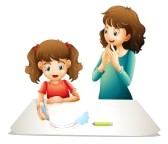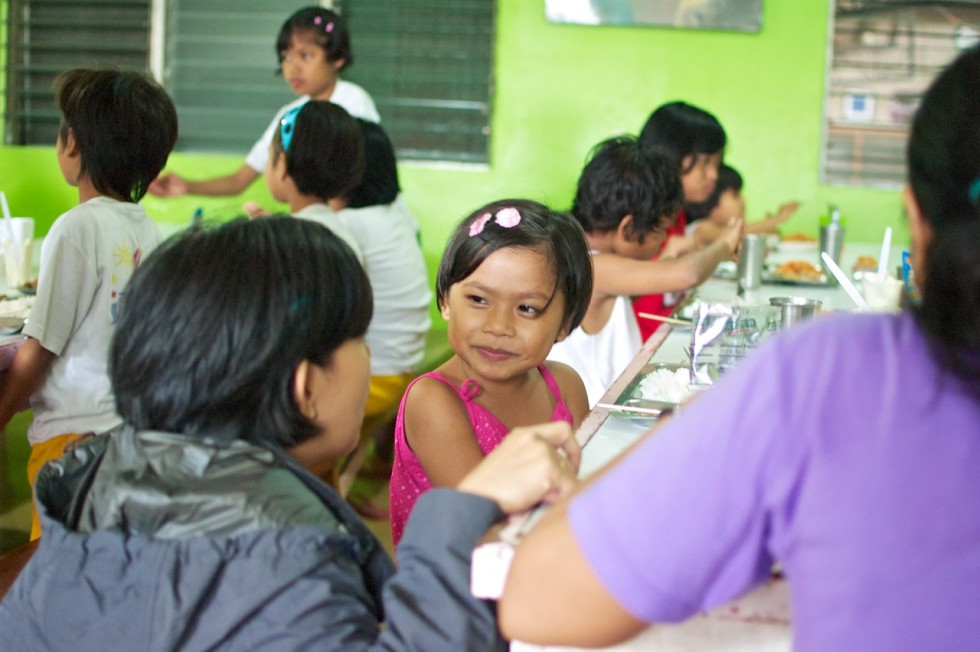Play, play, and play! Nothing is more exhilarating to a child than to have her parent ask her, “Can I play with you?” Just ordinary, everyday play. No fancy toys. Maybe no toys at all. Fifteen minutes a day is enough to a build powerful, lasting bond with their child.
There are names for this type of play, such as “floor time” or “child-directed play.” Social workers at Holt prefer to call it child-directed play because the name includes the active ingredient: the child directs the play just like a movie director. This type of unstructured, imaginative play gives the child the opportunity to write, cast and direct as the play spontaneously evolves. Kids often stick to one subject or scene over and over like a favorite book, so prepare yourself to get to know a part well and cheerfully play it out even for the twentieth time.[1]
Getting Started
As you are establishing your relationship and creating or strengthening bonds with your child, don’t negotiate anything about the play. This will diminish its impact. It is essential that you not take over the play. The only rule to impose would be “No Hurts,” or not hurting anyone. This includes things – no breaking things. Don’t criticize or accidently impose reality into the play. This type of play lies totally within the realm of your child’s imagination and you have to cast off your parent role and take on the role of a playmate. Create psychological space for the child’s ideas; if you are unsure of how to proceed or what your “part” is, whisper to your child, “What do you want me to do?” Kids are great at this and usually will whisper back your role without skipping a beat.
Don’t appear anxious to have the time end. If you have to keep to a time limit, set a timer. When the timer goes off, say something like, “Oh shucks, the timer went off. We have to stop playing. Can I help you pick up? Will you play with me again tomorrow?” Take a minute and visualize how powerful it would have been when you were a child to have your parent seeking you out to play with them. It sends a strong message that you value, like, enjoy, and love your child! It sounds very simple, but it can be harder than it appears to enter into a totally imaginative world where your child is in control for a change. If you make a mistake, just say you are sorry and you will try not to do that again. This goes a long, long way with a child.
Plan regular times to play with your child. Knowing your child, what time of day do you think playing with your child would have the most impact? For example, a morning play session may set the child up in a positive frame for the day, allowing them to carry that memory of love and fun with them. There may be times when it’s better to be flexible about when the playtime occurs. For example, your child wakes up from her nap and is out of sorts. Try playing for 15 minutes. Hopefully, she will laugh during the play, which just might turn her mood around. Maybe you need to get dinner on the table after work, but your child is out of sorts and asks to play or you sense a need to connect through play. She may have had a hard day at daycare or school. Unless your child is out of sorts due to low blood sugar, postponing dinner to play with your child may give her the emotional boost she needs to get through the evening in a secure and calm manner.
Your child may need to play multiple times in a day. Playing every two hours can help reduce her fear. This is like a pressure cooker letting off steam instead of blowing up. Watch your child, get to know her stress signals, and plan periods of play before these signals start. You can also use play to help your child cope with difficult transitions, such as before going grocery shopping. Try playing for a bit before the transition. Playful interactions reassure your child that she is loved. Remember, for this type of play to be effective, it has to be child-led or child-directed. This means that the child chooses what to play and tells the parent what to do. Parents set the amount of time – at least 15 minutes for each play period. The elements of play that are so powerful for attachment are those that are reciprocal and involve eye contact.
How Play Impacts Development
Play impacts infant, toddler and child development in many ways. It lowers anxiety, builds connectedness and trust, and improves learning and social competency. Play also teaches children attunement and awareness of others and their self. Let’s look at how this develops and what is lost if a child is not able to play.
Dr. Karyn Purvis, author of The Connected Child, equates play to a ladder of social competencies that are vital to building deep emotional bonds and learning social rules. Simple, playful interactions such as “goo-gooing” to an infant are the beginning. This evolves into a game of peek-a-boo which is teaching the infant timing of social interaction and what to expect. Through playful interactions, parents can help their adopted child build their ladder one rung at a time. Surrounding the child with a playful environment is the most effective thing a parent can do to help their child. Fifteen minutes a day is all it takes to reap huge rewards in the quality of your relationship with your child. This is a small investment in your parenting bank. It will help your child to accept the “no” answers that you have to give throughout the course of the day.
As children play, their brains release chemicals called neurotransmitters that support learning, the ability to create memory, and the ability to feel joy. This is one additional benefit of play, which impacts the child’s lifelong brain chemistry and creates positive attributes the child will use throughout life. Through these healthy, nurturing, playful parental connections, children develop a sense of self worth, emotional regulation, and the ability to relate to others. The brain also has excitatory hormones and stress chemicals that can become too high in children from hard places. Play lowers the amount of these neurotransmitters, opening the way for children to connect with others in healthy ways.
What Happens to Development if a Child Does Not Get to Play?
Parts of your child’s brain may have developed without parental input or guidance from a loving, nurturing caregiver. Adrift in an orphanage, group home, or even in some foster homes, a child has a hard time making sense of the world. In the absence of loving reciprocity, an infant and toddler’s mind develops very differently; protection and security are lacking, which floods the child with fear. Often, their main social interactions are with other children in the same environment. In this developmental void, misconceptions can be passed from one child to another, aggressions can go unchecked, and negative self-perceptions abound. Fear takes over every nook and cranny in the child’s being.
“Like an animal in the wild, they would only survive if they know where the threats are and where the opportunities exist. They are particularly attuned to the signals that indicate threat,” explains Dr. David Cross, co-director of Texas Christian University’s Child Development Institute . The reason these children can go from 0-60 without warning or apparent cause is because they are hyper-alert. Before coming home, their survival depended on this ability.
Love, prayer, time or reassurance will not disarm this hyper-sensitive fear response to life. Telling them will not convince them that they are safe; they must feel safe. “They think that they can still be harmed,” says Dr. Cross. The primitive part of their brain responsible for fight, flight or freeze responses has taken over.[2] It cannot fully shut down and is flooding their brain with stress chemicals such as cortisol. Stress hormones in children can easily be checked through saliva tests. These children are on high alert with cortisol levels twice as high as typically developing children. Dr. Karyn Purvis likens this condition to the equivalent of pouring bleach on the brain. On the outside, these children can even appear cool, calm, collected and very independent when not triggered by fear.
This fear is not checked at the door when your child enters your home. It has been with them for so long that they do not know anything different. Calmness can be scary to them. Fear, even though it causes so much dysfunction in their lives, is still a known quantity. It is kind of like selecting a draft pick of the lowest ranking player versus an unknown but outstanding walk on. Until this unknown player (the feeling of calmness) proves himself, you can’t trust him. You don’t know if you can depend on him in a game, even though in practice he continues to outplay everyone else.
Children who have not had the opportunity to experience healthy play at the appropriate developmental times have many symptoms that impact their life functioning. These include an impoverished ability to read social clues, which can cause them to look like they don’t have empathy. Their ability to interact in meaningful ways is also diminished or absent. They can look angry all the time and become isolated, their ability to regulate themselves is compromised and they can go from 0-60 in a flash both physically and emotionally. Often, they are aggressive and bossy.
“Most children from hard places feel they have to stay in control to stay alive. So when a parent says no, the child can experience it as a Death No in their emotional experience,” says Dr. Cross.
Teaching and using compromises is extremely effective in averting the emotional experience of a Death No. This is also why using puppets are effective because they provide a degree of separation between the emotionally charged social lesson and the child’s history. “It is so easy to forget that the building blocks for social competency are the kind of little playful teachings that parents would have done when they were tiny if these kids had been home with us. We want them to make leaps and bounds, but there is a ladder and we have to start where the children can reach,” says Dr. Purvis. If they start at a higher rung, parents and therapists are essentially trying to teach social skills to the part of the brain that failed to develop due to an absence of nurturing parental guidance. Like learning to communicate, first a child listens then babbles then may say a word here and there, then puts a few words together, then is making sentences, asking questions, then learning the alphabet, putting sounds and letter recognition together, learning to write individual letters and numbers, writing words, then reading, then composing, getting published and winning the Noble Peace Prize. All of this is built on those small pieces that needed to be in place before a child could make sense of the next step.
More Ways to Have Fun and Feel Safe
When the child can feel she is safe, not just reassured that she is safe, then she is able to develop trust and healthy attachments. There are many ways to create an environment that will help a child feel safe. In addition to the minimum daily requirement of 15 minutes/day of child-directed play, parents can engage in playful interactions with their child throughout the day. For example, keeping a light playful tone to your voice as you correct your child contributes to maintaining an environment of felt safety and keeps the fear response at bay. More information on this technique is contained in Dr. Purvis and Dr. Cross’ writings on the IDEAL response. A parent could use playfulness in teaching their child. Lessons accompanied by laughter are learned hundreds of times faster than teachable moments that do not elicit laughter. Teaching through play serves two purposes. First, it disarms fear. And second, children with brain differences learn better by actively engaging in the lesson – by “doing” – than solely by listening or observing
Again, puppets are one tool you can use to teach your child basic social skills. Some other techniques include practicing faces in a mirror, using feeling charts, and using a program called “How Does Your Engine Run?” This is a simple game using paper plates with green, yellow and red sections and a moveable arrow that a child can use to indicate if she is feeling too high in energy, just right, or low energy. Then the parent helps the child take care of her body to get to feeling just right again. This might be eating, a specific physical activity, or resting. When playful interactions permeate the environment, this signals safety and disarms the brain’s fear system.
The Older Child
Even middle school children who have missed out on these kinds of experiences can be surprisingly open to nurturing and playful interactions. For these ages, the activities should be interspersed with more talking and reflection.
For girls, good opportunities include activities such as applying nail polish or lipstick, when they’re doing their hair or make up, or during a foot or hand massage. For boys, rough-and-tumble play with dad is very powerful. A great activity for the whole family is the game Twister. Remember, your tween/teen could be at the emotional level of a toddler even though they’re in a big body!
What if All of This is Not Enough?
There are two types of therapy that are very helpful for parents of children from “hard places.” One is called “Theraplay” and the other is called “Trust-Based Parenting.” You can easily find them on the Internet and review their principles.
Theraplay can be effective for kids up to about 14 years of age. In this model of therapy, the goal is to create for the child the early building blocks of self-esteem, self-confidence, and connection that are involved in the formation of attachment. These building blocks include touch, rhythm, eye contact and singing. Theraplay helps the parents really attune to the developmental needs of the child, so that they can go back and fill in the gaps the child needs to shoot forward in healthy development.
Trust-Based Parenting is helpful for all ages. The Institute of Child Development at Texas Christian University keeps a referral list of therapists across the country who have received training in this model. This model encompasses many principles of Theraplay and stresses helping the child feel safe. It requires parents to learn new ways of interacting with their child, which is very good. If you have struggled to create lasting changes in your child’s emotional and social behaviors, then it is time for a new approach.
Like a fever is a symptom of an illness, misbehavior is often a symptom of fear.
Resources:
Books:
“The Connected Child” by Karyn Purvis, Ph.D.
“I Love You Rituals” by Becky Bailey, Ph.D
“The Whole Brained Child” by Daniel Siegel, M.D.
DVD “Playful Interaction: Unlocking the Mysteries of Nurturing Human Relationships” available from Texas Christian University, Institute of Child Development. www.child.tcu.edu/
Websites:
Theraplay Institute www.theraplay.org
How Does Your Engine Run? Leader’s Guide to the Alert Program for Self Regulation
[1] If the play your child makes up is scary, violent or traumatic in nature, please consult a child therapist. The child can actually be re-traumatizing herself through this type of play. In these conditions, it is OK for you to redirect the play by saying something like, “That is too scary for me to play. Can we play something else?” You could also ask if they know anyone who this has happened to.
2 “The Whole Brained Child” by Daniel Siegel, M.D. is devoted to this concept of a child’s brain being hijacked by their hippocampus and amygdala.
Abbie Smith, LCSW | Former Holt team member





